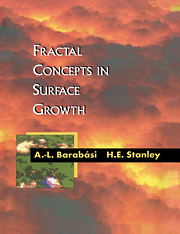Book contents
- Frontmatter
- Contents
- Preface
- Notation guide
- PART 1 Introduction
- 1 Interfaces in nature
- 2 Scaling concepts
- 3 Fractal concepts
- PART 2 Nonequilibrium roughening
- PART 3 Interfaces in random media
- PART 4 Molecular beam epitaxy
- PART 5 Noise
- PART 6 Advanced topics
- PART 7 Finale
- APPENDIX A Numerical recipes
- APPENDIX B Dynamic renormalization group
- APPENDIX C Hamiltonian description
- Bibliography
- Index
1 - Interfaces in nature
Published online by Cambridge University Press: 23 December 2009
- Frontmatter
- Contents
- Preface
- Notation guide
- PART 1 Introduction
- 1 Interfaces in nature
- 2 Scaling concepts
- 3 Fractal concepts
- PART 2 Nonequilibrium roughening
- PART 3 Interfaces in random media
- PART 4 Molecular beam epitaxy
- PART 5 Noise
- PART 6 Advanced topics
- PART 7 Finale
- APPENDIX A Numerical recipes
- APPENDIX B Dynamic renormalization group
- APPENDIX C Hamiltonian description
- Bibliography
- Index
Summary
Most of our life takes place on the surface of something. Sitting on a rock means contact with its surface. We all walk on the surface of the Earth and most of us don't care that the center of the Earth is molten. Even when we care about the interior, we cannot reach it without first crossing a surface. For a biological cell, the surface membrane acts not only as a highly selective barrier, but many important processes take place directly on the surface itself.
We become accustomed to the shapes of the interfaces we encounter, so it can be surprising that their morphologies can appear to be quite different depending on the scale with which we observe them. For example, an astronaut in space sees Earth as a smooth ball. However Earth appears to be anything but smooth when climbing a mountain, as we encounter a seemingly endless hierarchy of ups and downs along our way.
We can already draw one conclusion: surfaces can be smooth, such as the Himalayas viewed from space, but the same surface can also be rough, such as the same mountains viewed from earth. In general the morphology depends on the length scale of observation!
How can we describe the morphology of something that is smooth to the eye, but rough under a microscope? This is one question we shall try to answer in this book. To this end, we will develop methods to characterize quantitatively the morphology of an arbitrary interface.
- Type
- Chapter
- Information
- Fractal Concepts in Surface Growth , pp. 1 - 18Publisher: Cambridge University PressPrint publication year: 1995
- 1
- Cited by



